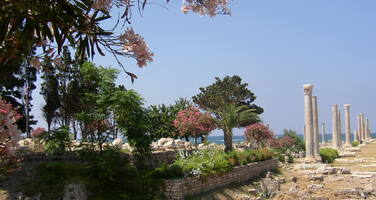Tyre
Factors affecting the property in 2001*
- Marine transport infrastructure
Factors* affecting the property identified in previous reports
- Need for an international safeguarding campaign (issue resolved)
- Construction of a tourist complex (land fill) (issue resolved)
- Construction project of a large fish market (issue resolved)
- Construction project of a coastal motorway (issue resolved)
- Uncontrolled construction
International Assistance: requests for the property until 2001
Total amount approved : 29,000 USD
| 2001 | Installation of Plaques and Publication of Leaflets to ... (Approved) | 2,500 USD |
| 2001 | Geoarchaeological study for the ancient ports of Tyre (Approved) | 20,000 USD |
| 1999 | Photo Exhibition on Lebanese (Baalbeck and Tyre) and ... (Approved) | 2,500 USD |
| 1986 | Consultancy to evaluate damage to Tyre (Approved) | 4,000 USD |
Missions to the property until 2001**
March 1995: UNESCO mission
Conservation issues presented to the World Heritage Committee in 2001
Within the framework of the new Master Plan for the City of Tyre, which is under elaboration, the Lebanese authorities had expressed their intention to build a new tourist marina, and have commissioned a feasibility study from a local firm. This study was to evaluate three possible options: 1) the rehabilitation and up-grading of the existing Tyre Port; 2) the extension of the existing Port of Tyre; and 3) the construction of a new port in Mheilib, three km north of Tyre.
After examining the feasibility study, the World Heritage Centre had recommended that option 1) be retained, taking into account the negative impact of the other two alternatives, both for the cultural heritage and natural setting of the site. The Centre, however, conditioned its approval to the accomplishment by the Lebanese authorities of the following:
· Full underwater survey inside the harbour.
· Limiting the number of boats docking in the tourist marina to a maximum of 30
· Using the marina project as an opportunity to upgrade the fishing port with the creation of amenities for fishermen and locations for the interpretation and presentation of the underwater heritage of Tyre.
As for the survey of the underwater heritage, the amount of US$ 20,000 was approved by the Chairperson of the WH Committee under the WH Fund as a contribution to this activity.
By letter dated 5 October 2001 addressed to the World Heritage Centre, the Director-General of the Antiquities Department of Lebanon confirmed that the Lebanese authorities, in line with the recommendations of the Centre, had eventually adopted the first option (rehabilitation and up-grading of existing port structures). Special attention would be paid to the safeguarding of the integrity and authenticity of the old fishing port.
As concerns the Master Plan, the Department of Antiquities confirmed the listing and protection, within the territory of Tyre, of vast areas around the main archaeological sites. These areas will be mostly surrounded by agricultural land, with building coefficients limited to 5%. The definition of the land-use for all other areas belonging to the State will be frozen until completion of the archaeological survey. The on-going World Bank projects (rehabilitation of the ancient city and presentation of the archaeological site) would complement the above efforts.
Summary of the interventions
Decisions adopted by the Committee in 2001
The Bureau may wish to adopt the following decision:
"The Bureau commends the Lebanese authorities on the important decisions taken for the safeguarding of the World Heritage site of Tyre, and recommends that, prior to any building activity within the ancient port, reports and detailed projects be transmitted to the Centre for submission to the Committee.”
* :
The threats indicated are listed in alphabetical order; their order does not constitute a classification according to the importance of their impact on the property.
Furthermore, they are presented irrespective of the type of threat faced by the property, i.e. with specific and proven imminent danger (“ascertained danger”) or with threats which could have deleterious effects on the property’s Outstanding Universal Value (“potential danger”).
** : All mission reports are not always available electronically.


